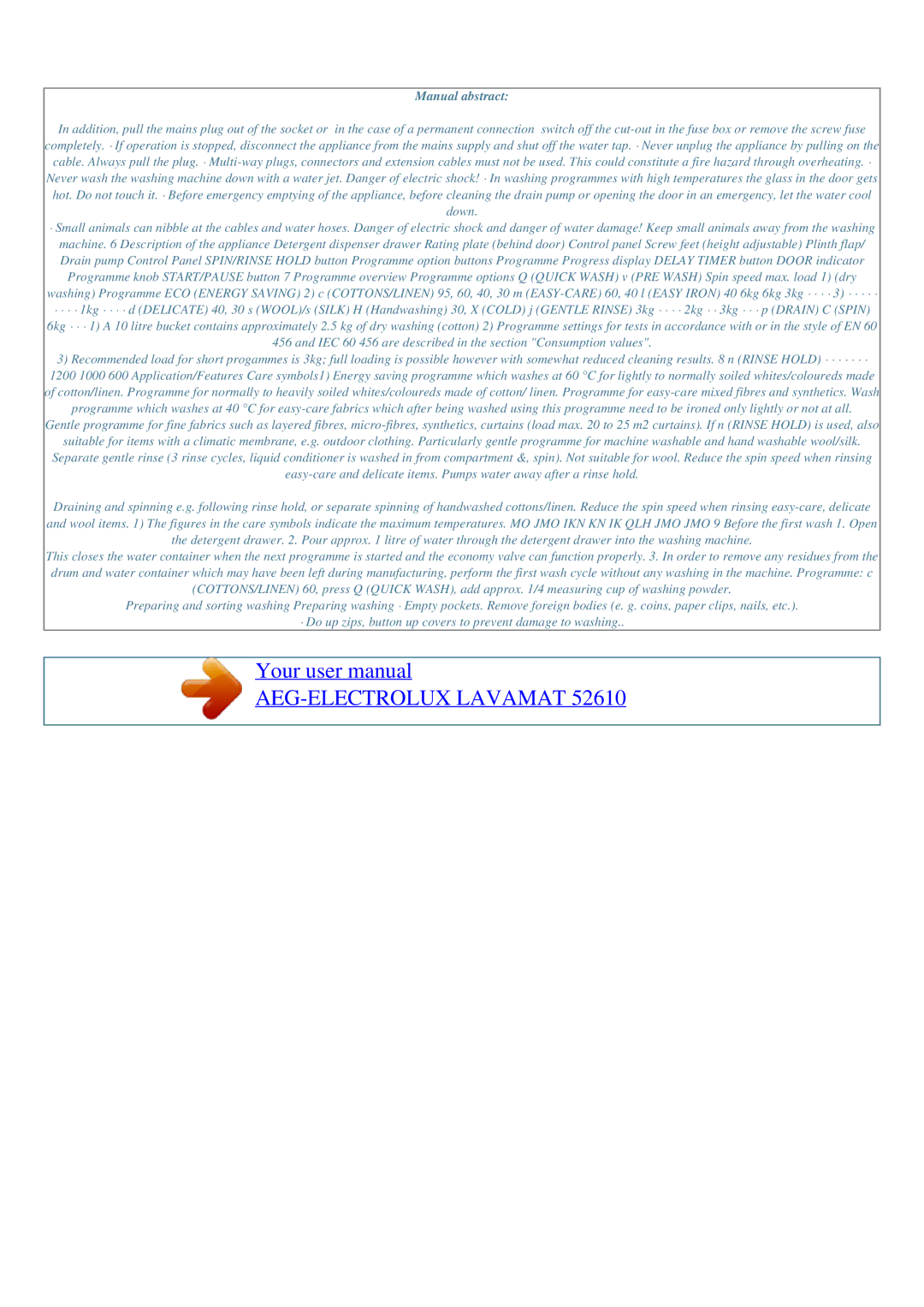
Manual abstract:
In addition, pull the mains plug out of the socket or in the case of a permanent connection switch off the
completely. · If operation is stopped, disconnect the appliance from the mains supply and shut off the water tap. · Never unplug the appliance by pulling on the cable. Always pull the plug. ·
·Small animals can nibble at the cables and water hoses. Danger of electric shock and danger of water damage! Keep small animals away from the washing machine. 6 Description of the appliance Detergent dispenser drawer Rating plate (behind door) Control panel Screw feet (height adjustable) Plinth flap/ Drain pump Control Panel SPIN/RINSE HOLD button Programme option buttons Programme Progress display DELAY TIMER button DOOR indicator
Programme knob START/PAUSE button 7 Programme overview Programme options Q (QUICK WASH) v (PRE WASH) Spin speed max. load 1) (dry
washing) Programme ECO (ENERGY SAVING) 2) c (COTTONS/LINEN) 95, 60, 40, 30 m
·· · · 1kg · · · · d (DELICATE) 40, 30 s (WOOL)/s (SILK) H (Handwashing) 30, X (COLD) j (GENTLE RINSE) 3kg · · · · 2kg · · 3kg · · · p (DRAIN) C (SPIN) 6kg · · · 1) A 10 litre bucket contains approximately 2.5 kg of dry washing (cotton) 2) Programme settings for tests in accordance with or in the style of EN 60
456 and IEC 60 456 are described in the section "Consumption values".
3)Recommended load for short progammes is 3kg; full loading is possible however with somewhat reduced cleaning results. 8 n (RINSE HOLD) · · · · · · ·
1200 1000 600 Application/Features Care symbols1) Energy saving programme which washes at 60 °C for lightly to normally soiled whites/coloureds made
of cotton/linen. Programme for normally to heavily soiled whites/coloureds made of cotton/ linen. Programme for
programme which washes at 40 °C for
Gentle programme for fine fabrics such as layered fibres,
suitable for items with a climatic membrane, e.g. outdoor clothing. Particularly gentle programme for machine washable and hand washable wool/silk.
Separate gentle rinse (3 rinse cycles, liquid conditioner is washed in from compartment &, spin). Not suitable for wool. Reduce the spin speed when rinsing
Draining and spinning e.g. following rinse hold, or separate spinning of handwashed cottons/linen. Reduce the spin speed when rinsing
This closes the water container when the next programme is started and the economy valve can function properly. 3. In order to remove any residues from the drum and water container which may have been left during manufacturing, perform the first wash cycle without any washing in the machine. Programme: c (COTTONS/LINEN) 60, press Q (QUICK WASH), add approx. 1/4 measuring cup of washing powder.
Preparing and sorting washing Preparing washing · Empty pockets. Remove foreign bodies (e. g. coins, paper clips, nails, etc.).
· Do up zips, button up covers to prevent damage to washing..
Your user manual
AEG-ELECTROLUX LAVAMAT 52610
Powered by TCPDF (www.tcpdf.org)
